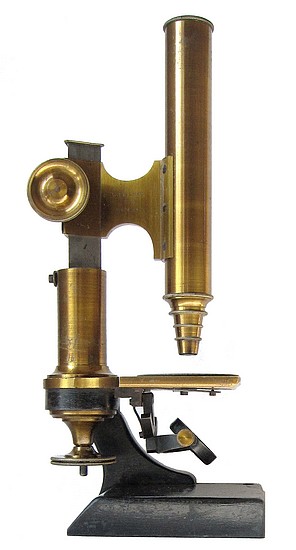
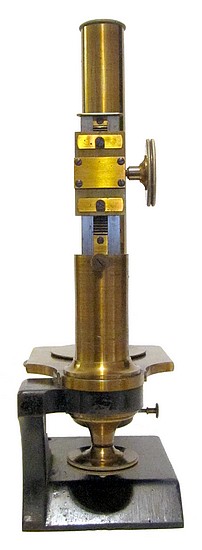
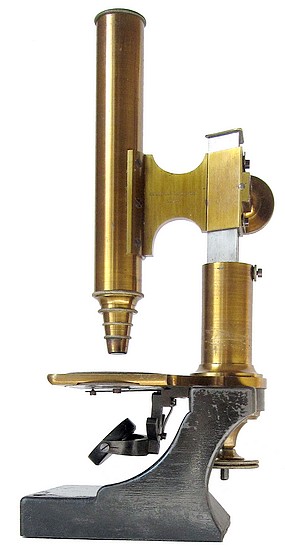
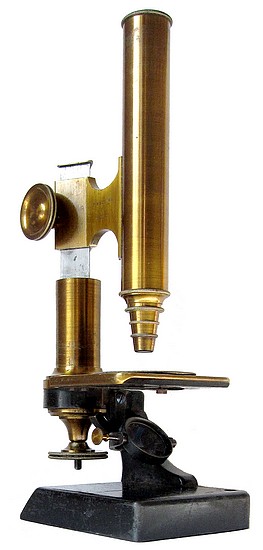
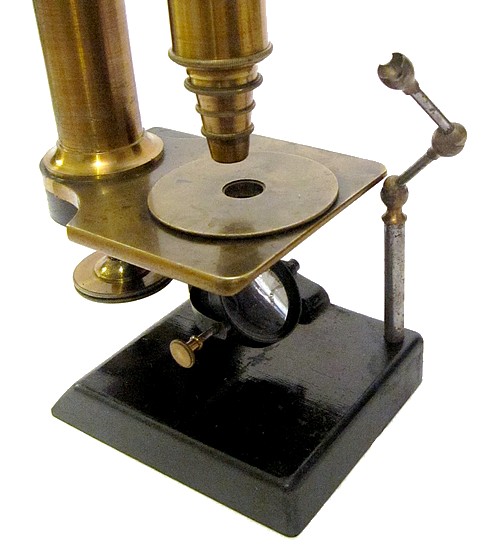
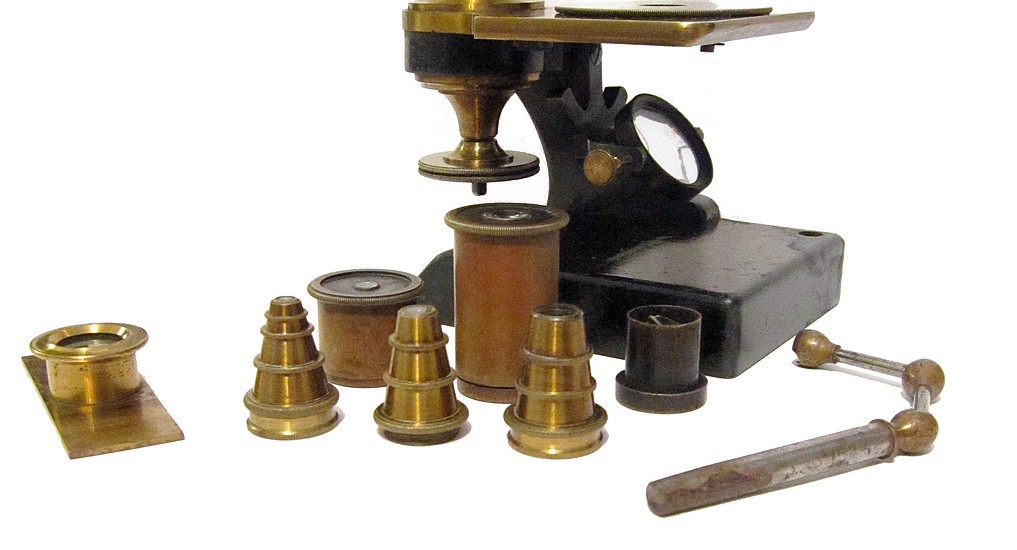
As shown in the figure, the microscope is 11.5 inches in height. The square base is iron painted black. The single sided concave mirror is attached to an arm with a swivel joint that allows lateral side to side adjustment of the mirror's position. The brass limb moves on a steel triangular shaft with inset brass rack. A brass plate engages the pinion of the coarse adjustment to the rack and has adjustment screws that allow the tension between the pinion and rack to be varied. The fine adjustment is by micrometer screw that is located at the rear under the stage. There is an adjustment screw that will allow any excess play of the fine adjustment to be taken up. The microscope is equipped with eyepieces numbered I and II and the objectives numbered 1, 2, and 3 which are also signed Belthle & Rexroth. Note that there is an articulated arm with ball and socket joints that fits into a hole in the base which might have held a stage condenser (now missing) or something else? Also, there is a Nicol prism in a brass mount. The live box is based in the English pattern and may not have been originally purchased with the microscope. The upper round stage plate can rotate about the optical axis. Below the stage is a rotating diaphragm with 7 apertures.
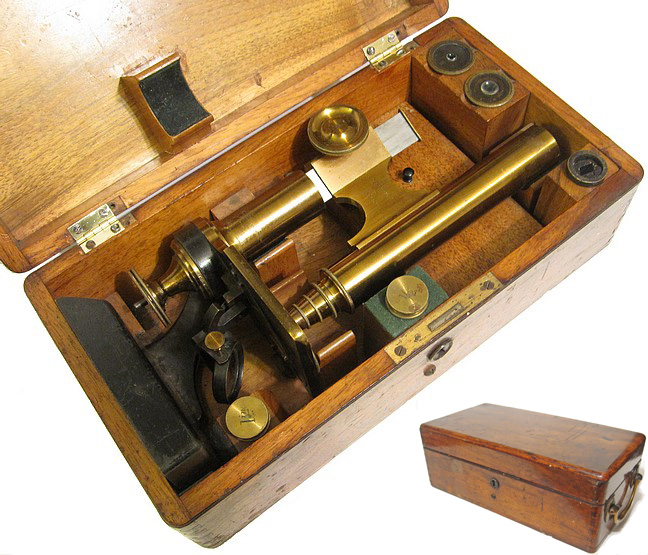
This is an example of the middle-sized model produced by the firm; see: C. Kellner in Wetzlar gegründeten Instituts Nachfolger: Belthle and Rexroth Price list for 1858
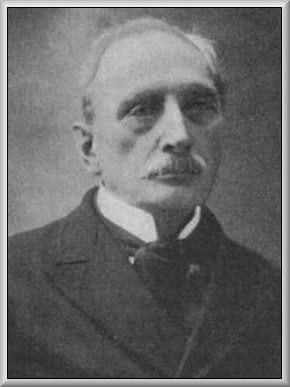
Dr. Louis Bauer, MD (1814-1898)
This microscope was
purchased for this collection from a source located in
the United States. A search of the production
archives retained by Leica Microsystems GmbH of
microscopes made in the early period of the Optical
Institute in Wetzlar indicates that this Belthle &
Rexroth microscope with serial number 280 was sold to
Louis Bauer of the Brooklyn City on February, 1859 (
an extract from the delivery book is reproduced here). Dr. Louis Bauer (1814-1898)
has been referred to as "the father of
orthopaedic surgery in the United
States."
Louis Bauer was born in
Stettin, the provincial capital of Pomerania. He
received a good education and in 1833 he began his
study of medicine at the Universities of Greifswald,
Breslau, and Berlin. In 1838, he passed the state
examinations and qualified as a physician, surgeon, and
obstetrician.
While he was engaging in
a private practice and functioning as the district
physician in Kreiss County, East Prussia, he was also
active in politics. His participation in a democratic
movement in opposition to the Crown resulted in a
10-week imprisonment in 1848. Because of this and
likely facing additional imprisonment, he was forced to
move his practice to England and in 1852 he became a
member of the London Medical Society. However, a year
later he emigrated to the United States and settled in
New York, in a section then known as Brooklyn
City.
There, along with a
fellow German immigrant physician Gustav Braeunlich, he
founded, in 1856, what was initially called the
Brooklyn German General Dispensary. Within a short
time, the name of the institution was changed to the
Long Island College Hospital (today it is now known as
the Downstate Medical Center); this was America's first
college hospital.
Bauer held an appointment
as Professor of Anatomy and Surgery at the hospital. In
addition, he later was made Health Officer of Brooklyn
City and served in that capacity for two years. He also
served as the pathologist for the Brooklyn coroner and
was a frequent lecturer at the Brooklyn Medical and
Surgical Institute. During his 16 years in Brooklyn,
Bauer wrote many articles and books among which was a
work considered to be the first American textbook of
orthopaedic surgery, Lectures on Orthopaedic
Surgery, published in 1864 and a textbook of
orthopaedic surgery in German, Handbuch der
Orthopadischen Chirurgie, published in 1870. As a
pathologist, he also showed an interest in the use of
the microscope in medicine as evidenced by his 1859
publication of the English translation of Gustaf von
Duben's Treatise on Microscopical Diagnosis.
Interestingly, it was just at about that time that he
came into possession of the Belthle and Rexroth
microscope described herein. His accomplishments as an
author, as well as his surgical skills and the
treatments he pioneered for orthopedic diseases bought
him renown within the profession.
In 1869, with the
encouragement of some German residents of St. Louis,
Bauer moved to that city. By 1878, Bauer chartered the
St. Louis College of Physicians and Surgeons where he
held the position of Professor of Surgery. He later
became the dean of this institution, a position he held
for 12 years. He continued to publish on orthopaedic
and other medical subjects until his death on November,
5, 1898 at the age of 84. Today he is often referred to
as "a pioneer in American orthopaedic surgery".
The professional life
Louis Bauer is best summarized by this quote from the
final paragraph of the Alferd R. Shands biographical
article:
"He was a German born
orthopaedic surgeon who lived in Brooklyn (1853-1869)
and St. Louis (1869-1898); he was one of the chief
founders of a medical school in each city; he wrote the
first American orthopaedic textbook, which was a
classic of its day; he founded in Brooklyn the second
orthopaedic institution in the United States, which was
the first in New York; he was a strong advocate of
"rest-absolute and unconditional" for joint disease; he
was spoken of by Sir Arthur Keith, as "the real founder
of the American School of Orthopaedics"; he was greatly
admired by Hugh Owen Thomas, who spoke of him as "the
best exponent of American orthopaedics"; he was
mentioned in the National Cyclopedia of American
Biography in 1894 as being, "undoubtedly the father of
orthopaedic surgery in the United States"; and he was a
dynamic but controversial figure in American
orthopedics for over forty years in the second half of
the nineteenth century".
Some publications by Louis Bauer.
References:
Shands, A. R. Jr., Louis Bauer, a pioneer in American orthopaedic surgery, Curr. Pract. Orthop. Surg., 3, 18-36, 1966.
Goff, C. W., Louis Bauer-Orthopaedist Extraordinary, Clin, Orthop., 8, 3-6, 1956.
Termine, J. E., SUNY Downstate Medical Center, The Founding of America's First College Hospital, chap. 1, Arcadia Pub., Charleston, SC, 2000.
Historical Committee, Biographical Sketch of Louis Bauer M.D., F.R.C.S., Brooklyn Med. J., 13, 266-267, 1899.
(I would like to thank Dr. Timo Mappes and Rolf Beck of Leica Microsystems GmbH for their help in obtaining information from the early archives of the firm; without their assistance, the association of this instrument with Dr. Bauer could not have been made.)
For more information about this microscope, related instruments, and the history of the Leitz firm, see the article:
Some Early Microscopes from the Optical Institute in Wetzlar